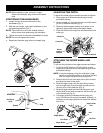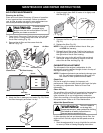
9
Add fuel in a clean,
well ventilated
outdoor area. Wipe up any spilled fuel
immediately. Avoid creating a source of
ignition for spilt fuel. Do not start the engine
until fuel vapors dissipate.
WARNING:
Gasoline is
extremely
flammable. Ignited Vapors may explode.
Always stop the engine and allow it to cool
before filling the fuel tank. Do not smoke
while filling the tank. Keep sparks and open
flames at a distance from the area.
WARNING:
Remove fuel cap
slowly to avoid injury
from fuel spray. Never operate the unit
without the fuel cap securely in place
.
WARNING:
RECOMMENDED FUEL TYPE
Old fuel is the primary reason for improper
unit performance. Be sure to use fresh,
clean, unleaded gasoline.
NOTE: This is a four cycle engine. In order to avoid
damage to the unit, do not mix oil with gasoline.
Definition of Blended Fuels
Today's fuels are often a blend of gasoline and
oxygenates such as ethanol, methanol or MTBE (ether).
Alcohol-blended fuel absorbs water. As little as 1%
water in the fuel can make fuel form acids when stored.
When using alcohol-blended fuel, use fresh fuel that is
less than 60 days old.
Using Blended Fuels
If you choose to use a blended fuel, or if its use is
unavoidable, follow recommended precautions:
• Always use fresh unleaded gasoline
• Use Sta-Bil
®
or an equivalent
• Drain tank and run the engine dry before storing unit
Using Fuel Additives
The use of fuel additives, such as Sta-Bil
®
or an
equivalent, will inhibit corrosion and minimize the
formation of gum deposits. Using a fuel additive can
keep fuel from forming harmful deposits in the
carburetor for up to six (6) months. Add 0.8 oz. (23 ml.)
of fuel additive per gallon of fuel to an approved gas
container according to the instructions on the container.
NEVER add fuel additives directly to the unit's gas tank.
OIL AND FUEL INFORMATION
FUELING THE UNIT
NOTE: Fill or add fuel to the tank only when the
cultivator is in a horizontal position (Fig. 9).
1. Remove fuel cap. Remove the tag from the fuel tank
neck.
2. Place spout of gas container into the fill hole on the
fuel tank and fill tank.
NOTE: Do not overfill tank.
3. Wipe up any gasoline that may have spilled.
4. Reinstall the fuel cap.
5. Move the unit at least 30 ft. (9.1 m) from the fueling
source and site before starting the engine.
NOTE: Dispose of the old gasoline in accordance to
Federal, State and Local regulations.
Fig. 9
Fuel Cap


















